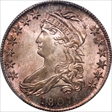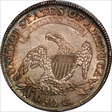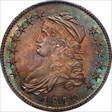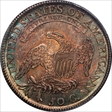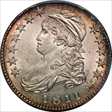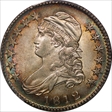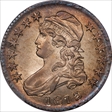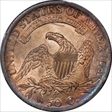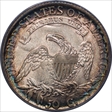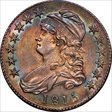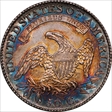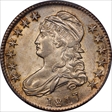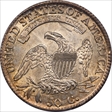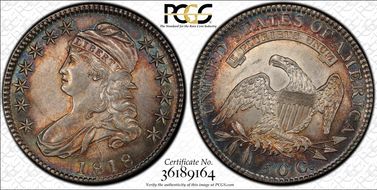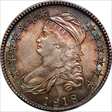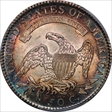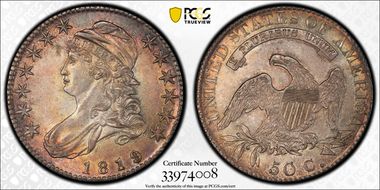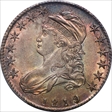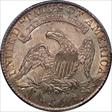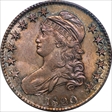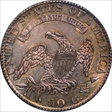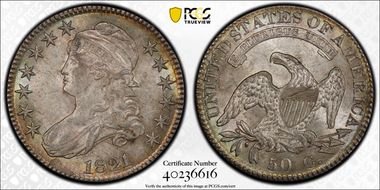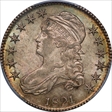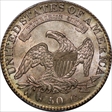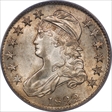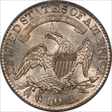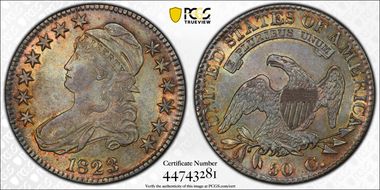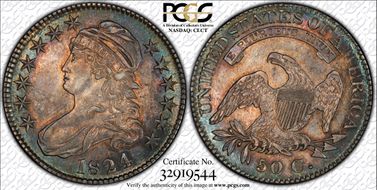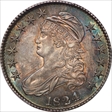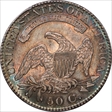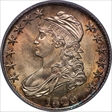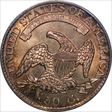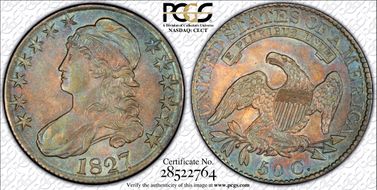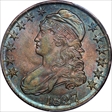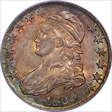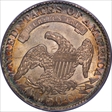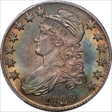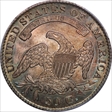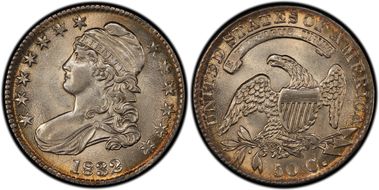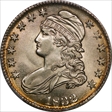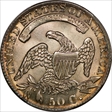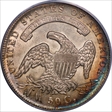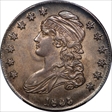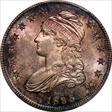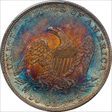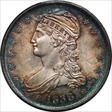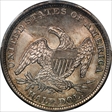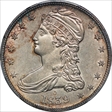The Coastal Collection (Everyman) 的钱币相册
O.112, R1. CAC. Ex-Sears, ex-Osborne. Fabulous luster and flash.
O.112, R1. CAC. Ex-Sears, ex-Osborne. Fabulous luster and flash.
O.112, R1. CAC. Ex-Sears, ex-Osborne. Fabulous luster and flash.
O.101, R1. CAC. Ex-Davignon. Hammered! Sheridan Downey's catalog description: Ex Gerald Schertz. The surfaces, while virtually free of contact marks, feature a wonderful morass of die breaks and clash marks. Only a peacock might aspire to the range of iridescent colors that grab and hold the viewer’s eye. Keith purchased the coin from me in June 1994; it was part of the nearly complete die variety set of Dr. Gerald Schertz, BHNC #45.
O.101, R1. CAC. Ex-Davignon. Hammered! Sheridan Downey's catalog description: Ex Gerald Schertz. The surfaces, while virtually free of contact marks, feature a wonderful morass of die breaks and clash marks. Only a peacock might aspire to the range of iridescent colors that grab and hold the viewer’s eye. Keith purchased the coin from me in June 1994; it was part of the nearly complete die variety set of Dr. Gerald Schertz, BHNC #45.
O.107a, R3. CAC. This variety is notable, and was collected for its different edge lettering. For reasons we can only guess, four of 1809's 15 varieties have XXX characters stamped into the edge. Four other varieties used III inscriptions. (One variety, the O.108 shows both.) A good guess is that this was done to repair flawed die bars but no one really knows. According to Ivan Leaman and Donald Gunnet's 1986 report, Edges and Die Sequences on Early Half Dollars... ...three of the 1809 edges bear ornamentation and are called the experimental edges. The third edge exhibits heavy vertical grooves at the beginning of each bar in front of FIFTY and HALF. The fourth edge is called the engrailed edge. There is a series of X-like figures at the front of the first bar and at the end of the second. The sixth edge contains only 106. There are light grooves in the front of HALF. We call this the pseudo-engrailed edge.
O.107a, R3. CAC. This variety is notable, and was collected for its different edge lettering. For reasons we can only guess, four of 1809's 15 varieties have XXX characters stamped into the edge. Four other varieties used III inscriptions. (One variety, the O.108 shows both.) A good guess is that this was done to repair flawed die bars but no one really knows. According to Ivan Leaman and Donald Gunnet's 1986 report, Edges and Die Sequences on Early Half Dollars... ...three of the 1809 edges bear ornamentation and are called the experimental edges. The third edge exhibits heavy vertical grooves at the beginning of each bar in front of FIFTY and HALF. The fourth edge is called the engrailed edge. There is a series of X-like figures at the front of the first bar and at the end of the second. The sixth edge contains only 106. There are light grooves in the front of HALF. We call this the pseudo-engrailed edge.
O.104a, R1. Cataloger's description: A thin ring of iridescent toning outlines the dentils. The untoned centers are alive with cartwheel luster. Here is a coin that never saw circulation. Minuscule signs of handling befit the 58 designation. Well struck and ready for a home in a first class die variety or Red Book set.
O.104a, R1. Cataloger's description: A thin ring of iridescent toning outlines the dentils. The untoned centers are alive with cartwheel luster. Here is a coin that never saw circulation. Minuscule signs of handling befit the 58 designation. Well struck and ready for a home in a first class die variety or Red Book set.
O.108a R2. CAC. Ten marriages for 1813, more than 1.2 million minted, most with weak-to-good strike. This version is a favorite. Formerly owned by Prouty (as a MS62), and more recently by the late Roger Solomon. It is simply superb: a sharply impressed EDS obverse is paired with a well used but nicely struck reverse. The die pair produced halves with very weak milling...often incomplete. Overton states: Many specimens show rim damage in minting, especially on the reverse and adjacent to AMERICA. The 108a die state is more common than the 108 R4. Obverse die cracks and incomplete reverse milling characterize it. Color is attractive silver and gold with a bit of burnt orange. Surfaces are all but mark free, save some Mint clashing. The luster is remarkably full and strong. Only the very slightest rub can be seen at upper left wing.
O.108a R2. CAC. Ten marriages for 1813, more than 1.2 million minted, most with weak-to-good strike. This version is a favorite. Formerly owned by Prouty (as a MS62), and more recently by the late Roger Solomon. It is simply superb: a sharply impressed EDS obverse is paired with a well used but nicely struck reverse. The die pair produced halves with very weak milling...often incomplete. Overton states: Many specimens show rim damage in minting, especially on the reverse and adjacent to AMERICA. The 108a die state is more common than the 108 R4. Obverse die cracks and incomplete reverse milling characterize it. Color is attractive silver and gold with a bit of burnt orange. Surfaces are all but mark free, save some Mint clashing. The luster is remarkably full and strong. Only the very slightest rub can be seen at upper left wing.
O.102a, R3. 1814 is a very fun year for CBH enthusiasts. Nine die marriages were produced from a mintage of just over 1 million, the fourth lowest of the series. Among these nine marriages of this historically important year were the 1814/3 overdate (Overton 101), the very scarce single leaf (Overton 105a) and the major variety E over A (Overton 108).
O.102a, R3. 1814 is a very fun year for CBH enthusiasts. Nine die marriages were produced from a mintage of just over 1 million, the fourth lowest of the series. Among these nine marriages of this historically important year were the 1814/3 overdate (Overton 101), the very scarce single leaf (Overton 105a) and the major variety E over A (Overton 108).
O.101, R2. CAC. From the George Hamilton collection, lot 4093. Originally housed in an NGC old fattie graded AU55 with a CAC gold sticker. The catalog description: It is challenging to find an 1815/2 half dollar with any degree of eye appeal. They are by and large a dull lot, and many of the surviving pieces are impaired in one way or another. The present coin is a wonderful exception. Originally toned in attractive blue, violet, and tangerine-gold toning, both sides are brightly lustrous and sharply struck. Aside from the inevitable die clashing, there are no marks of consequence. Housed in an early generation NGC holder from about 25 years ago (with hologram but without the barcode), this Choice About Uncirculated coin carries the CAC gold sticker indicating it is undergraded by at least one level. An interesting bit of trivia about the 1815/2 is that the entire lot of coins struck in early Jan 1816 were paid out to a single customer: Jones, Firth and Co. How often can we trace provenance and know with certainty the original owner?
O.101, R2. CAC. From the George Hamilton collection, lot 4093. Originally housed in an NGC old fattie graded AU55 with a CAC gold sticker. The catalog description: It is challenging to find an 1815/2 half dollar with any degree of eye appeal. They are by and large a dull lot, and many of the surviving pieces are impaired in one way or another. The present coin is a wonderful exception. Originally toned in attractive blue, violet, and tangerine-gold toning, both sides are brightly lustrous and sharply struck. Aside from the inevitable die clashing, there are no marks of consequence. Housed in an early generation NGC holder from about 25 years ago (with hologram but without the barcode), this Choice About Uncirculated coin carries the CAC gold sticker indicating it is undergraded by at least one level. An interesting bit of trivia about the 1815/2 is that the entire lot of coins struck in early Jan 1816 were paid out to a single customer: Jones, Firth and Co. How often can we trace provenance and know with certainty the original owner?
O.101, R2. CAC. From the George Hamilton collection, lot 4093. Originally housed in an NGC old fattie graded AU55 with a CAC gold sticker. The catalog description: It is challenging to find an 1815/2 half dollar with any degree of eye appeal. They are by and large a dull lot, and many of the surviving pieces are impaired in one way or another. The present coin is a wonderful exception. Originally toned in attractive blue, violet, and tangerine-gold toning, both sides are brightly lustrous and sharply struck. Aside from the inevitable die clashing, there are no marks of consequence. Housed in an early generation NGC holder from about 25 years ago (with hologram but without the barcode), this Choice About Uncirculated coin carries the CAC gold sticker indicating it is undergraded by at least one level. An interesting bit of trivia about the 1815/2 is that the entire lot of coins struck in early Jan 1816 were paid out to a single customer: Jones, Firth and Co. How often can we trace provenance and know with certainty the original owner?
O.101, R2. CAC. From the George Hamilton collection, lot 4093. Originally housed in an NGC old fattie graded AU55 with a CAC gold sticker. The catalog description: It is challenging to find an 1815/2 half dollar with any degree of eye appeal. They are by and large a dull lot, and many of the surviving pieces are impaired in one way or another. The present coin is a wonderful exception. Originally toned in attractive blue, violet, and tangerine-gold toning, both sides are brightly lustrous and sharply struck. Aside from the inevitable die clashing, there are no marks of consequence. Housed in an early generation NGC holder from about 25 years ago (with hologram but without the barcode), this Choice About Uncirculated coin carries the CAC gold sticker indicating it is undergraded by at least one level. An interesting bit of trivia about the 1815/2 is that the entire lot of coins struck in early Jan 1816 were paid out to a single customer: Jones, Firth and Co. How often can we trace provenance and know with certainty the original owner?
O.112a, R2. For 1817 Chief Engraver Scot produced a new MD and struck new WH from which WD were made. Relief was somewhat lowered and central hair details were modified...thinner and more detailed, as were the folds in the cap. Liberty got a nose job, smaller and more attractive, and the relief of her cheek and jaw was improved. And yet not enough WD's were produced and the Mint had to rely on earlier ones, using an 1814 first (the ultra-rare 1817/4 variety), the obverse of which quickly broke after a handful of struck coins. The old 1813 die lasted longer, striking tens of thousands. For inspection, here is a pretty example from this tough year. This CBH has excellent luster with just a hint of toning at the periphery. An EDS obverse is paired with a shattered reverse giving this eye appealing coin nice character.
O.112a, R2. For 1817 Chief Engraver Scot produced a new MD and struck new WH from which WD were made. Relief was somewhat lowered and central hair details were modified...thinner and more detailed, as were the folds in the cap. Liberty got a nose job, smaller and more attractive, and the relief of her cheek and jaw was improved. And yet not enough WD's were produced and the Mint had to rely on earlier ones, using an 1814 first (the ultra-rare 1817/4 variety), the obverse of which quickly broke after a handful of struck coins. The old 1813 die lasted longer, striking tens of thousands. For inspection, here is a pretty example from this tough year. This CBH has excellent luster with just a hint of toning at the periphery. An EDS obverse is paired with a shattered reverse giving this eye appealing coin nice character.
O.107, R.5 From the Sept 2021 Legend Auction (H. Scharfman collection). Ex. Floyd Farley Collection; to Charlton (Swampy) Meyers circa 1996; Selected Rarities from the Meyer Collection, Sheridan Downey Mail Bid, July 2008, lot 32 (as NGC AU58); Dr. Charles Link Collection; sold via private treaty to Keith Davignon April 2010; private treaty sale to Dr. Charles Link (as PCGS AU58), March 2014; private treaty sale to our consignor, April 2017 Catalog description: An extremely difficult Rarity 5 die marriage, the O-107 is about on par with the 1812/1 Large 8 in terms of number known. Identifiable by broken A and E punches on the reverse, missing the serifs of both letters. This impressive, borderline Uncirculated example has one of the greatest pedigrees for the Capped Bust half dollar connoisseurs--it reads as a who's who of old time and recent Bust Half Nuts! Only the slightest hint of friction can be detected by a strong glass, indeed PCGS got it right grade wise. The underlying luster is bold, and while this coin may have been dipped ages ago, storage in an old Kraft envelope since that time has imparted a lovely pastel blue, gold, and rose tone. Generally very well struck up overall, we note just a touch of weakness at the tip of the bust. The eye appeal is sensational for this incredibly RARE variety. PCGS 1, NGC 0. This coin sold privately in 2017 for $46,500 and the Don Frederick AU58 sold privately in June 2020 for $56,000.
O.107, R.5 From the Sept 2021 Legend Auction (H. Scharfman collection). Ex. Floyd Farley Collection; to Charlton (Swampy) Meyers circa 1996; Selected Rarities from the Meyer Collection, Sheridan Downey Mail Bid, July 2008, lot 32 (as NGC AU58); Dr. Charles Link Collection; sold via private treaty to Keith Davignon April 2010; private treaty sale to Dr. Charles Link (as PCGS AU58), March 2014; private treaty sale to our consignor, April 2017 Catalog description: An extremely difficult Rarity 5 die marriage, the O-107 is about on par with the 1812/1 Large 8 in terms of number known. Identifiable by broken A and E punches on the reverse, missing the serifs of both letters. This impressive, borderline Uncirculated example has one of the greatest pedigrees for the Capped Bust half dollar connoisseurs--it reads as a who's who of old time and recent Bust Half Nuts! Only the slightest hint of friction can be detected by a strong glass, indeed PCGS got it right grade wise. The underlying luster is bold, and while this coin may have been dipped ages ago, storage in an old Kraft envelope since that time has imparted a lovely pastel blue, gold, and rose tone. Generally very well struck up overall, we note just a touch of weakness at the tip of the bust. The eye appeal is sensational for this incredibly RARE variety. PCGS 1, NGC 0. This coin sold privately in 2017 for $46,500 and the Don Frederick AU58 sold privately in June 2020 for $56,000.
O.107, R.5 From the Sept 2021 Legend Auction (H. Scharfman collection). Ex. Floyd Farley Collection; to Charlton (Swampy) Meyers circa 1996; Selected Rarities from the Meyer Collection, Sheridan Downey Mail Bid, July 2008, lot 32 (as NGC AU58); Dr. Charles Link Collection; sold via private treaty to Keith Davignon April 2010; private treaty sale to Dr. Charles Link (as PCGS AU58), March 2014; private treaty sale to our consignor, April 2017 Catalog description: An extremely difficult Rarity 5 die marriage, the O-107 is about on par with the 1812/1 Large 8 in terms of number known. Identifiable by broken A and E punches on the reverse, missing the serifs of both letters. This impressive, borderline Uncirculated example has one of the greatest pedigrees for the Capped Bust half dollar connoisseurs--it reads as a who's who of old time and recent Bust Half Nuts! Only the slightest hint of friction can be detected by a strong glass, indeed PCGS got it right grade wise. The underlying luster is bold, and while this coin may have been dipped ages ago, storage in an old Kraft envelope since that time has imparted a lovely pastel blue, gold, and rose tone. Generally very well struck up overall, we note just a touch of weakness at the tip of the bust. The eye appeal is sensational for this incredibly RARE variety. PCGS 1, NGC 0. This coin sold privately in 2017 for $46,500 and the Don Frederick AU58 sold privately in June 2020 for $56,000.
O.101, R1. CAC. Original, old grey dirt with flashy luster. The perfect CAC coin.
O.101, R1. CAC. Original, old grey dirt with flashy luster. The perfect CAC coin.
O.118, R1. Wonderful, deep amber toning along with exceptional luster. Maybe the most fun-thing about this bust half is its nearly perfect strike...the best I've seen of the screw press series.
O.118, R1. Wonderful, deep amber toning along with exceptional luster. Maybe the most fun-thing about this bust half is its nearly perfect strike...the best I've seen of the screw press series.
O.122, R5. CAC. Cataloger's description: From the Dr. Charles Link collection, earlier in the Frederick collection, as noted on the PCGS label. Here is one of the 2 or 3 most important coins in the sale. Frederick’s 2x2 envelope accompanies. He wrote (in July 1980), “Easily the finest known of this very rare variety. Beautifully toned and choicely preserved, AU/AU+.” One uncirculated example has since surfaced, the De Olden PCGS MS 64, offered in MB 32, June 2006, lot 83, @$9,533. The Frederick/Link coin stays at #2 in the Condition Census, tied with the Meyer coin, also graded PCGS AU 58 (sold privately in July 2008 for $5,800). The toning on the current example is otherworldly! Preview is necessary. Any description will fall short, but must allude to the rose colored centers, surrounded by electric shades of turquoise and blue. Contact marks are absent. Cartwheel luster is undiminished in the fields. There is but a trace of friction on Liberty’s cheek.
O.122, R5. CAC. Cataloger's description: From the Dr. Charles Link collection, earlier in the Frederick collection, as noted on the PCGS label. Here is one of the 2 or 3 most important coins in the sale. Frederick’s 2x2 envelope accompanies. He wrote (in July 1980), “Easily the finest known of this very rare variety. Beautifully toned and choicely preserved, AU/AU+.” One uncirculated example has since surfaced, the De Olden PCGS MS 64, offered in MB 32, June 2006, lot 83, @$9,533. The Frederick/Link coin stays at #2 in the Condition Census, tied with the Meyer coin, also graded PCGS AU 58 (sold privately in July 2008 for $5,800). The toning on the current example is otherworldly! Preview is necessary. Any description will fall short, but must allude to the rose colored centers, surrounded by electric shades of turquoise and blue. Contact marks are absent. Cartwheel luster is undiminished in the fields. There is but a trace of friction on Liberty’s cheek.
O.122, R5. CAC. Cataloger's description: From the Dr. Charles Link collection, earlier in the Frederick collection, as noted on the PCGS label. Here is one of the 2 or 3 most important coins in the sale. Frederick’s 2x2 envelope accompanies. He wrote (in July 1980), “Easily the finest known of this very rare variety. Beautifully toned and choicely preserved, AU/AU+.” One uncirculated example has since surfaced, the De Olden PCGS MS 64, offered in MB 32, June 2006, lot 83, @$9,533. The Frederick/Link coin stays at #2 in the Condition Census, tied with the Meyer coin, also graded PCGS AU 58 (sold privately in July 2008 for $5,800). The toning on the current example is otherworldly! Preview is necessary. Any description will fall short, but must allude to the rose colored centers, surrounded by electric shades of turquoise and blue. Contact marks are absent. Cartwheel luster is undiminished in the fields. There is but a trace of friction on Liberty’s cheek.
O.119, R3. Ex-Premium Collection, Don Willis. B&M 11/07 lot 2242. A special variety for 1828. It is the only one struck from the small legend letters reverse; note also the filled A in AMERICA. And look closely to see that STATES was punched too far left then the WD was lapped and repunched correctly. This handsome half dollar has brilliant, full luster with satiny surfaces. Sharp strike and free of any distracting abrasions. Wonderful eye appeal.
O.119, R3. Ex-Premium Collection, Don Willis. B&M 11/07 lot 2242. A special variety for 1828. It is the only one struck from the small legend letters reverse; note also the filled A in AMERICA. And look closely to see that STATES was punched too far left then the WD was lapped and repunched correctly. This handsome half dollar has brilliant, full luster with satiny surfaces. Sharp strike and free of any distracting abrasions. Wonderful eye appeal.
O.115, R2. Cataloger's description: Eye appeal! Gorgeous rainbow toning blankets the pleasing surfaces. What’s not to like about this one?! Be sure to preview it in person. From the Cape Cod Collection.
O.115, R2. Cataloger's description: Eye appeal! Gorgeous rainbow toning blankets the pleasing surfaces. What’s not to like about this one?! Be sure to preview it in person. From the Cape Cod Collection.
O.101, R1. Dark gray & brown dirt with full, rolling luster, clean, smooth fields, deep, rich, original toning and just a bare hint of friction on the obverse only. No rub at all on the reverse. Ex-Jules Reiver (Heritage, January 2006 lot 23311 as NGC AU-58).
O.101, R1. Dark gray & brown dirt with full, rolling luster, clean, smooth fields, deep, rich, original toning and just a bare hint of friction on the obverse only. No rub at all on the reverse. Ex-Jules Reiver (Heritage, January 2006 lot 23311 as NGC AU-58).
GR-17 (JR-20), R1. One of the more common varieties and easily available. The obverse is normally well struck but the reverse, even in EDS, shows a significant die crack from 6 o'clock to 11. The reverse die in this example is counter clockwise rotated about 30 degrees. The half has remarkable, vivid toning emphasizing sea blue and green, soft magenta, and fiery orange.
GR-17 (JR-20), R1. One of the more common varieties and easily available. The obverse is normally well struck but the reverse, even in EDS, shows a significant die crack from 6 o'clock to 11. The reverse die in this example is counter clockwise rotated about 30 degrees. The half has remarkable, vivid toning emphasizing sea blue and green, soft magenta, and fiery orange.
GR-5, R2. A frosty, lustrous example of the last year in the series. Untoned and likely carefully dipped. Exceptional reverse strike and a weaker obverse. Some typical planchet roller marks but most subtle. (Was PCGS MS61, cert# 32919580)
GR-5, R2. A frosty, lustrous example of the last year in the series. Untoned and likely carefully dipped. Exceptional reverse strike and a weaker obverse. Some typical planchet roller marks but most subtle. (Was PCGS MS61, cert# 32919580)





















